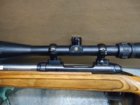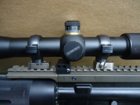With the scope set in the middle of its elevation travel, you will have 12.5 mil up and 12.5 mil down travel. To counter the effect of gravity on the bullet's trajectory and zero the rifle at some distance, you dial the elevation turret up, effectively moving the scope reticle down (opposite direction). As you raise the rifle higher to bring the reticle on target, you're pointing the barrel upward. The key here is that at "zero", the scope axis is essentially parallel to the barrel, so a bullet will drop below the line of sight very quickly. So it's common to think of the total scope elevation travel by halves: upward travel and downward travel. You want an angled base to help you get back some of the scope's downward elevation travel, meaning the bottom half of its total travel range.
That means a base with up 12.5 mil cant will allow you to "regain" the downward elevation travel. One mil is an equivalent angle to approximately 3.44 MOA, so that means you could theoretically use a base with up to (12.5 mil x 3.44 MOA/mil) = 43 MOA total, to regain the bottom half of your elevation travel. In reality, these things don't always work put exactly as they might calculate out on paper. Nonetheless, it should be be fairly close in practice.
The concern with using a scope base with a significant amount of cant is that you may lose the ability to zero at closer range. For example, I have a number of scopes that theoretically should all be able to zero at 100 yd with a 20 MOA base. In fact, all do except one. For shooting F-TR at 1000 yd, using a 20 MOA base means that the scope erector is not at the extreme end of its elevation travel range, and the optics will therefore be slightly better. Presumably, you're wanting a canted base for similar reasons, i.e. long range shooting. The bottom line is that you can use a base with almost whatever total amount of cant you wish, or at least whatever you can buy. However, once you go past the 12.5 mil (43 MOA) downward travel of your scope, you will only be able to zero at minimum distances farther and farther away. So you could theoretically put a 50 MOA, or even 80 MOA base under the scope, but you might only be able to zero at a minimum distance of 300 yd, or 600 yd, or farther. However, the steeper the the cant of the base, the farther out the elevation travel you gain would allow the scope to zero within its elevation travel.
The real question is how much elevation travel will be useful to you? I guess if you knew you would only be shooting a rifle from 1000 yd to 3000 yd, you might go with a very highly canted base. This is a situation that ELR shooters sometimes find themselves in. Of course, they are using calibers that will reach out that far, and don't have any need to zero at close range. Your scope's total elevation travel will not change by putting a canted base under it. You are simply changing the angle of the scope with a canted base so as to put its total elevation travel within a range that is useful for your purposes and suitable for the specific setup its mounted on.
As another example, I have a very accurate .22 rimfire bolt rifle on which I mounted a NF 12-46x56 BR scope, which has 40 MOA total elevation travel. The scope base has zero MOA cant. If desired, I can zero this rifle at ranges from less than 10 yd, out to about 150 yd maximum. I sometimes participate in an online rimfire shooting competition where the targets are shot occasionally as far as 200 yd. With a zero cant base, I simply cannot dial the scope enough to hit 200 yd, so I have to use an aimpoint well above (> 2 ft.) the target I am actually trying to shoot. It is not optimal, but I don't use if for that purpose very often, so I have not been inclined to put a 20 MOA canted base on it. If I did, the farthest distance for which I could zero the scope would increase, but at the same time, the closest distance I could zero the scope would move farther out. Since I shoot that rifle by far the most often at distances of 50 to 100 yd, it is not in my best interest to put a canted base on it at this time. You're in a similar position. So as indicated above, somewhere arpund a 40 MOA base would get you most of your elevation travel back. Anything more than that and your minimum close range zero distance is going to go up as well. The other consideration might be how "steady" adjustable scope bases such as the one pictured actually are as compared to a fixed base. If they're not rock solid, it will be a problem. In contrast, a fixed base will obviously limit you to that specific cant (i.e. not adjustable).














